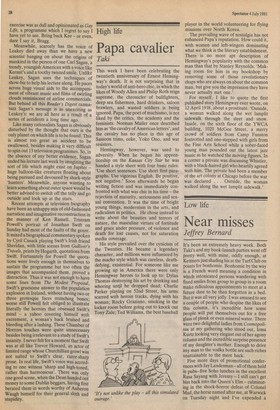High life
Papa cavalier
Tab
This week I have been celebrating the twentieth anniversary of Ernest Hemingway's death. It is not surprising that in today's world of anti-hero chic, in which the likes of Woody Allen and Philip Roth reign supreme, the chronicler of bullfighters, deep sea fishermen, hard drinkers, saloon brawlers, and wasted soldiers is being ignored. Papa, the poet of machismo, is not liked by the critics, the academy and the feminists. Norman Mailer once described him as 'the cavalry of American letters', and the cavalry has no place in this age of Sassoon trims, coke, Yoko Ono, and war resisters.
Hemingway, however, was used to adversity. When he began his apprenticeship on the Kansas City Star he was handed a style sheet with four basic rules: 'Use short sentences. Use short first paragraphs. Use vigorous English. Be positive, not negative.' Soon afterwards he began writing fiction and was immediately confronted with what was chic in his time — the rejection of maturity, seriousness and sexual convention. It was the time of bright young things, modernism in the arts, and radicalism in politics. He chose instead to write about the beauties and terrors of nature, the masculine virtues of fortitude and grace under pressure, of violence and death for lost causes, not for saturation media coverage.
His style prevailed over the cynicism of the Twenties. He became a legendary character, and millions were influenced by the macho style which was careless, deathdefying, existential. For someone like me growing up in America there were only Hemingway heroes to look up to: Dylan Thomas destroying his art by drinking and whoring until. he dropped dead; Charlie Parker playing on 52nd Street, his arms scarred with heroin tracks, dying with his woman; Rocky Graziano, smoking in the locker room before going out to knock out Tony Zale; Ted Williams, the best baseball player in the world volunteering for flying missions over North Korea.
The prevailing wave of nostalgia has not enhanced Papa's reputation. How could it, with women and left-wingers dominating what we think is the literary establishment. There is no more apt description of Hemingway's popularity with the common man than that by Stanley Reynolds: 'Making room for him in my bookshop by removing some of those revolutionary chaps who are always on about the common man, but give you the impression they have never actually met one.'
For myself, I like to quote the first published story Hemingway ever wrote, on 12 April 1918, about a prostitute. 'Outside, a woman walked along the wet lamplit sidewalk through the sleet and snow. Inside, on the sixth floor of the YWCA building, 1020 McGee Street, a merry crowd of soldiers from Camp Funston foxtrotted and one-stepped with girls from the Fine Arts School while a sober-faced young man pounded out the latest jazz music as he watched the moving figures. In a corner a private was discussing Whistler, with a black-haired girl who heartily agreed with him. The private had been a member of the art colony at Chicago before the war was declared . . . Outside, the woman walked along the wet lamplit sidewalk.'






































 Previous page
Previous page